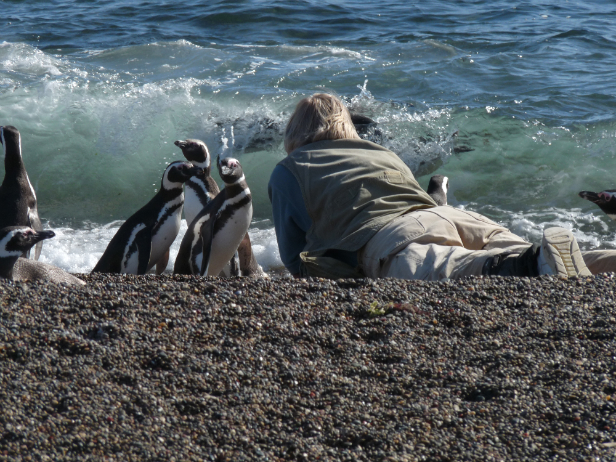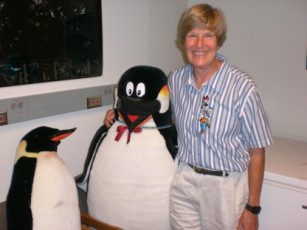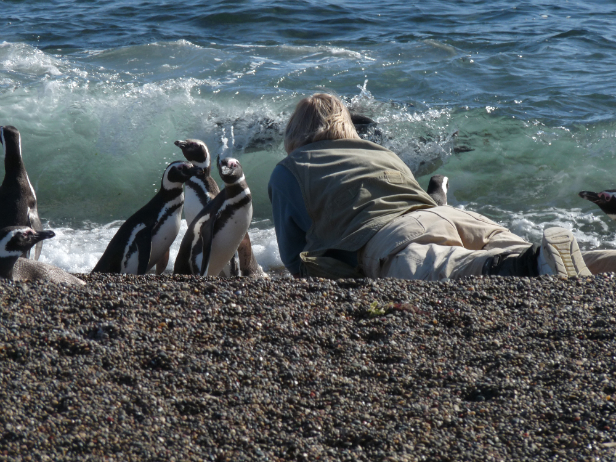 University of Washington researcher Dr. P. Dee Boersma has spent nearly 40 years following her passion to learn about and protect penguins.Courtesy of Dee Boersma/Penguin Sentinels www.penguinstudies.org
University of Washington researcher Dr. P. Dee Boersma has spent nearly 40 years following her passion to learn about and protect penguins.Courtesy of Dee Boersma/Penguin Sentinels www.penguinstudies.org
There once was a Michigan schoolteacher who gave her little girl a butterfly net and a suggestion: Every kid should have a hobby, could collecting insects be yours?
The little girl, driven by curiosity and a sense of duty, embraced her mother’s words so completely that, for a long time, the schoolteacher believed that her daughter had caused the crash of butterfly populations across the entire Midwest.
Of course, the real threat was pesticides such as DDT.
The little girl grew up and moved on. Now, she chases penguins, whose numbers are also spiraling downward. This time, climate change is one of the culprits.
The butterfly-and-penguin chaser is Dr. P. Dee Boersma, a preeminent penguin researcher at the University of Washington in Seattle, where she holds the Wadsworth Endowed Chair in Conservation Studies. A 2009 winner of the prestigious Heinz Award, Dr. Boersma has spent nearly 40 years studying penguins from the Galapagos Islands to Argentina. I sat down with her to chat about penguin commute times, the human population problem, and why you should have a TV.
People love penguins because penguins are like people
Dr. Boersma first fell “madly in love with penguins” when she was doing her PhD research in the Galapagos Islands in the 1970s. Since then, she’s moved further south and for the past 27 years, she and her research crews have been following Magellanic penguins along the temperate southeastern coast of Argentina.
 Perhaps Dr. Boersma keeps these model penguins in her University of Washington lab as a reminder that penguins are a lot like people: both are struggling with climate change.Photo: Ashley BraunWhy bother studying the same group of penguins for so long? Because long-term research like Dr. Boersma’s comes in extremely handy when looking at what an increasingly warmer world does — if anything — to the creatures that live in it.
Perhaps Dr. Boersma keeps these model penguins in her University of Washington lab as a reminder that penguins are a lot like people: both are struggling with climate change.Photo: Ashley BraunWhy bother studying the same group of penguins for so long? Because long-term research like Dr. Boersma’s comes in extremely handy when looking at what an increasingly warmer world does — if anything — to the creatures that live in it.
Magellanic penguins, for example, can swim more than 100 miles each day in search of a nice fish dinner. After eating it (and hopefully leaving a good tip), they book it back to the nests to feed their fluffy chicks before the food is digested in their own stomachs.
“It’s not that different than [human] parents that are trying to raise their kids,” noted Dr. Boersma. (Except that your parents probably didn’t regurgitate into your sippy cup.)
Analyzing satellite data from tagged penguins Dr. Boersma discovered that climate change is forcing these penguins to swim twenty-five miles farther each foraging trip to find food than they were traveling a decade ago. A situation Dr. Boersma compared to a human family where mom’s office has moved from San Diego, where the family still lives, up to San Francisco, where mom now works. The longer commute means mom spends more money on fuel and less time and energy at home. It’s basically the same for a penguin family. Except penguins can’t store extra food in the fridge, and if papa penguin also leaves the nest for food, the kids might get eaten by an armadillo.
“Penguins … [are] having to commute farther to be able to find fish,” said Dr. Boersma. “That’s the price they’re paying for the change and variability of climate.” Courtesy of Dee Boersma/Penguin Sentinels www.penguinstudies.org
Staring down a changing world without knowing it
Dr. Boersma observed firsthand another deadly example of the effects of climate variation. On the Antarctic Peninsula, she saw a “rain-on-snow” event, an elusive phenomenon that occurs when sudden bouts of warm air cause falling snow to turn to rain or slush. Some experts think warmer temperatures could increase the frequency of these events. That is especially bad news for penguin chicks. Their downy feathers are adapted to keeping out the cold of frozen snow. However, when snow turns to rain, young penguins get drenched and freeze to death.
Not all the effects of — or research on — a changing global climate are so glaringly obvious to the general public. “As one guy said to me, ‘Well, you believe in climate change,'” Dr. Boersma mentioned. “And I said, ‘I don’t believe in climate change. The scientific evidence is overwhelming. Climate has changed. We’re continuing to see more rapid changes.’ He said, “Well, I don’t believe in climate change.’ And I said, ‘Well, you don’t have to. You can believe in how many angels dance on the head of a pin. That is a belief. But the scientific evidence is really very clear on all of these things.'”
This evidence of global environmental changes often is “difficult for us to even see in our lifetime, but if we take an historical perspective, the changes have been monumental,” she said. “In the last two generations, we went from mostly having a wild world to mostly now having a human world.”
Both a threat and a savior
Indeed, though climate change presents a grave threat to penguins, “the greatest threat” of all, said Dr. Boersma, is the human race.
“We have 6.7 billion people in the world, and we all want to consume more,” she said. “As long as people aspire to the standard of living of Americans, we don’t have enough resources. What we should really be talking about is how are we going to get a world population of about 2 billion, and how are we going to get the most consumptive countries to reduce their consumption.”
Outside of mandated population controls, how does she propose we get from here to there?
“It starts a person at a time,” Dr. Boersma said. “I have no children. And I have certainly done that intentionally because I think there are too many people in the world.”
That’s what the Discovery Channel is for
Dr. Boersma emphasized the importance of connecting with the natural world, something she and her graduate students get the chance to do at her research station in Punta Tombo, Argentina, where she’s been studying penguins the last 27 years. Recently, they befriended a lone male penguin they call “Turbo.” Turbo doesn’t have a mate to make him raise a chick or take out the trash and instead has taken to paying visits to their research station. He knocks on the door with his beak and waddles right inside.
“I think people have to have that sort of experience with something that’s other than human,” said Dr. Boersma. “And if they do, it can change their life.”
That experience can even be vicarious.
“It’s one of the reasons it’s important to have not only television so you have the Discovery Channel … but also zoos and aquariums,” Dr. Boersma said. “Not everybody’s going to be able to go to Africa, or to Peru.”
A magazine can work toward that end as well. In 2001, she launched Conservation Magazine. Its mission, says Dr. Boersma, the magazine’s executive editor, is “to get the news out so that anybody who is interested in conservation can read interesting ideas, stimulating science that they can understand.”
Scientists who do extra credit
While Dr. Boersma has been an outspoken advocate of the Wildlife Conservation Society for years, she acknowledged that the type of passionate activism practiced by NASA researcher James Hansen is a step beyond what most scientists find comfortable.
“I think Hansen’s been an amazing advocate for something he cares deeply about,” she said. “He’s taken on activism to try to alert the public to what he sees are fundamental problems. Sometimes scientists don’t want to go quite as far as he does, but I think we all have an obligation to communicate what the loss is going to be and what scientific experiments we’re running with humans as the guinea pig.”
 If penguin stalking were an Olympic event, Dr. Boersma would have taken home the gold.Penguins have clearly been the cause in Dr. Boersma’s life. Her devotion earned her a 2009 Heinz Award. Teresa Heinz established the award in honor of her late husband, U.S. Senator John Heinz. She bestows it on select individuals each year for their “extraordinary accomplishments” in areas that were particularly near and dear to him.
If penguin stalking were an Olympic event, Dr. Boersma would have taken home the gold.Penguins have clearly been the cause in Dr. Boersma’s life. Her devotion earned her a 2009 Heinz Award. Teresa Heinz established the award in honor of her late husband, U.S. Senator John Heinz. She bestows it on select individuals each year for their “extraordinary accomplishments” in areas that were particularly near and dear to him.
The prize comes with a $100,000 gift and a big, shiny medal — the part Dr. Boersma secretly is most excited about receiving. Her plans for the money don’t involve any trips to a magical children’s theme park. Instead, she’ll spend it on her three passion projects: The Penguin Sentinals, Conservation Magazine, and Global Penguin Society.
“As I was kidding a friend, it’s not enough to buy a coastline in Oregon to retire to,” Dr. Boersma said. “So I think I’ll continue to try to work on changing the world.”
————————————
Correction: This story originally stated that Magellanic penguins are swimming 25 miles farther to find food each day, rather than each foraging trip. The author regrets the error.



